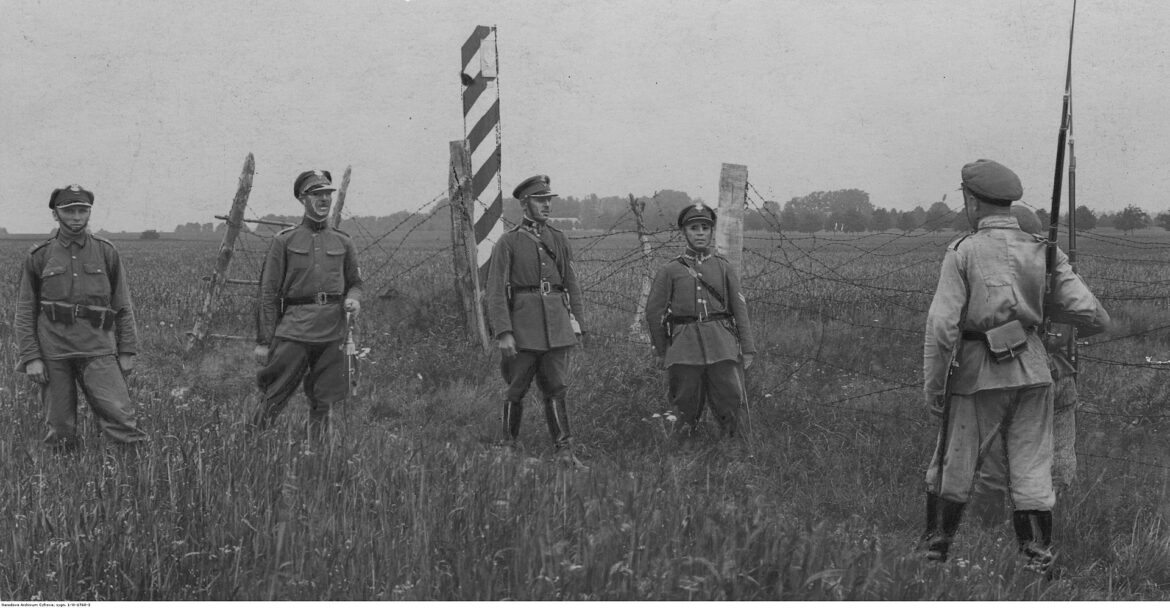In 1924, as a result of Soviet sabotage attacks, the authorities of the Second Polish Republic decided to create a special military formation to protect the borders – the Border Protection Corps (Korpus Ochrony Pogranicza). During the 15 years of its functioning, the soldiers of KOP – not only completed their basic tasks, but also participated in activities of a cultural and social nature. In 1939, they fought heroic battles against both the Germans and the Soviets. Many of them were murdered in the Katyn Massacre in 1940.
After Poland regained its independence in 1918, and especially after the end of the war with Soviet Russia and the signing of the peace treaty in Riga in 1921, a key task for the state authorities became securing the eastern state border. Despite the peace treaty, the Soviet Union more or less openly contested the territorial division, claiming that land inhabited by Byelorussians and Ukrainians had been incorporated into Poland, contrary to the principle of self-determination of peoples proclaimed by the Moscow authorities.
In addition to propaganda activities, the Soviets supported and inspired terrorist attacks by gangs attacking Polish border areas, often from the Soviet territory. From 1923, the protection of the Polish borders was ensured by subdivisions of the State Police, which, however, due to insufficient forces, were unable to carry out their tasks in this regard. In 1924, more than 200 acts of sabotage and assaults involving 1,000 bandits took place in the Eastern Borderlands, in which more than 50 people were killed. These activities culminated in the summer 1924. On the night of 3 to 4 August, a Soviet diversionary unit of more than 100 people attacked the district town of Stolpce, which lay 15km from the border. The saboteurs destroyed the police headquarters, set fire to the district office and railway station buildings and looted all the shops.
The attack prompted the Polish authorities, at a special cabinet meeting (21-22 August 1924), to decide to create a special military formation to protect the Polish border areas. On 12 September 1924, General Władysław Sikorski, then Minister of Military Affairs, issued an order to create the Corps of Border Protection (Korpus Ochrony Pogranicza – KOP), and a few days later the General Staff of the Polish Army issued an instruction defining the structure of the new formation. Interestingly, due to the specificity of the tasks assigned to it, KOP was subordinate to both the Ministry of Military Affairs (personnel, organisational and training matters) and the Ministry of Internal Affairs (implementation of tasks related to border protection, ensuring security in the border zone and financing activities).
The headquarters of the KOP command was located in Warsaw. It included 6 brigades, consisting of infantry battalions and cavalry squadrons. The first commander was General Henryk Minkiewicz. He held this position until May 1929, when he was replaced by Gen. Stanisław Tessaro (until October 1930). From October 1930 until August 1939, the formation was commanded by General Jan Kruszewski. The last commander of the KOP was General Wilhelm Orlik -Rückemann.
Due to the nature of the service of the newly-formed army, it was decided that the professional officer and non-commissioned officer cadre, as well as privates, would be carefully selected. The latter were sent there after completing six months of unitarian training as part of their basic service. The headquarters made efforts to select soldiers of good repute, good physical shape and Polish nationality, which was not always respected. The principle was also the requirement that an officer’s service in KOP units should not exceed 3 years. The forces of the border formation were to number nearly 28,000 soldiers. The new units began to garrison the eastern border areas relatively quickly, starting as early as the beginning of November. They began their service primarily at those most threatened areas by the activities of Soviet terrorist bands.
The main tasks of the KOP were to protect the border against attacks by hostile forces, to combat smuggling, and to ensure internal security in the 30km-wide border strip (in the latter respect in close cooperation with the State Police). KOP soldiers also conducted intelligence activities. Interestingly, the border formation carried out extensive measures for the benefit of the local communities in order to gain their social trust. They included the organisation of cultural and educational ceremonies, KOP soldiers also provided support in the event of natural disasters, especially frequent floods. The local population also benefited from military medical and veterinary assistance. All these activities were positively received by the local population.
In the first years of KOP’s functioning, a huge challenge for the command was to create a proper infrastructure to provide accommodation for serving soldiers. In the first period (until 1931), more than 100 border watchtowers and many other structures were built. Importantly, they were all connected by a telephone network developed from scratch.
After Germany attacked Poland on 1 September 1939, KOP soldiers took part in battles against the aggressor. Węgierska Górka, in Silesia, was defended by a fortress company commanded by Tadeusz Semik. Between 7 and 10 September, the Battle of Wizna took place, in which Polish units (about 700 soldiers), commanded by Captain Władysław Raginis, an officer of the KOP, held off an overwhelming German army (about 40,000, soldiers) commanded by General Heinz Guderian for 2 days.
After the Soviet Union’s aggression against Poland on 17 September, the invaders were faced mainly by KOP troops, trying to delay the aggressor’s march as much as possible. The KOP forces were grouped by General Wilhelm Orlik-Rückemann, who decided to head towards Wlodawa. A grouping of nearly 9,000 soldiers fought a victorious battle of Shatsk on 29-30 September 1939. After crossing the Bug River and marching towards Parczew, the last battle between KOP and Soviet units took place near Wytyczne on October 1. After the battle, General Orlik-Rückemann disbanded the formation.
The vast majority of KOP soldiers taken prisoner by the Soviet Union were murdered in the Katyn Massacre.





